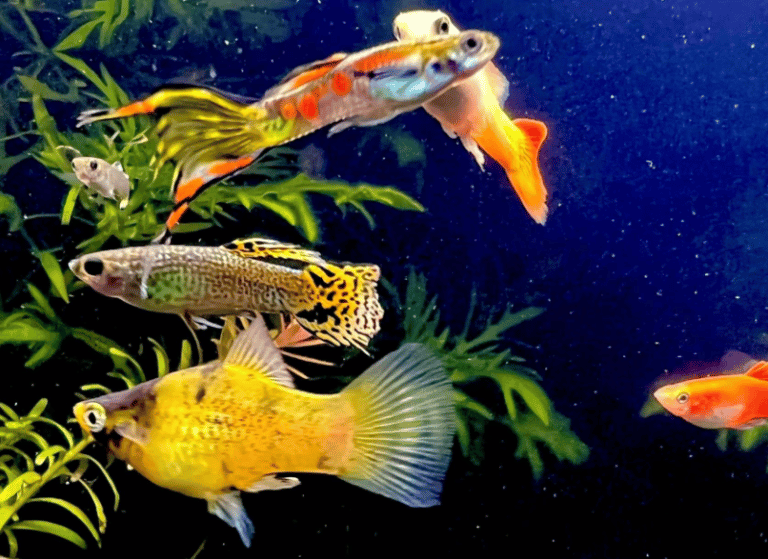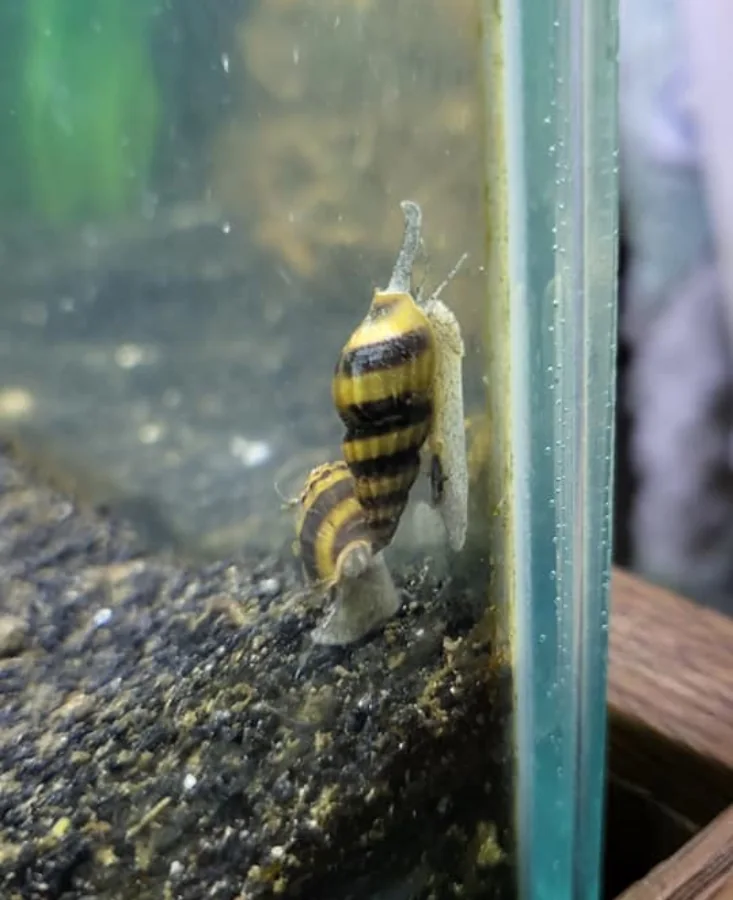Mystery snails lay eggs in clutches just above the aquarium’s waterline. Each clutch contains between 50 and 300 eggs, although some species lay up to 500 in a single clutch. A female mystery snail can lay up to 500 eggs per year, but all of them need to be fertile to hatch.
But how do you know the eggs are fertile?
You can tell if mystery snail eggs are fertile or infertile by their color, smell, and growth. Fertile eggs will turn slightly grey, grow in size, and form dark spots as they approach hatching, while Infertile eggs will have a uniform size and color for days, develop a foul smell, and stain a damp paper towel easily.
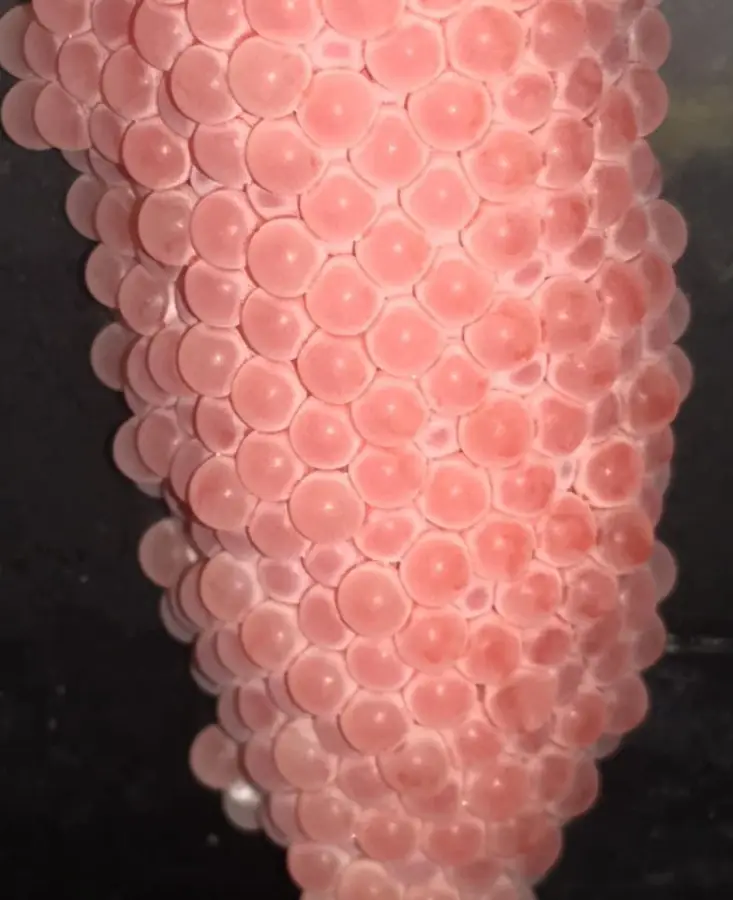
Keeping male and female mystery snails is ideal
If you’re attempting to breed mystery snails and increase their number in your aquarium, we recommend keeping both male and female snails to encourage mating. The snails will most likely produce fertile eggs.
Mystery snails can lay infertile eggs if a viable male is not available to fertilize them. Being dioecious, male and female snails are sexually distinct and cannot change.[1] Therefore, to increase the probability of fertile eggs being laid, you should have both male and female mystery snails in the tank.
A female mystery snail will turn translucent when ready for breeding. The male mystery snail will mount on her and fertilize her eggs. You will notice because the snails will be stuck together for a few hours.
How to tell mystery snail eggs are fertile
Mystery snail eggs are covered in a gelatinous mass that protects and nourishes the developing snails before hatching. But, it can be difficult for a beginner aquarist to distinguish between fertile and infertile snail eggs.
Here are ways to tell mystery snail eggs are fertile:
1. Fertile eggs will grow and change color
In the first 48 hours after the eggs are laid, they are small, pink, and soft. Afterward, they will harden and change their color to brown. They will also grow in size and form dark spots when they approach hatching. The dark spots are baby mystery snails, so you can treat them as a sign of life.
The eggshell will also start to thin as the baby mystery snails will eat the inner of the shell as they try to come out. They will appear dark grey with an irregular shape
Infertile eggs will have a uniform size and color for days and even weeks.
Clutches take between 9 days to 5 weeks to hatch based on their environment. During this period, they will undergo certain changes.
- Stage 1: Freshly laid eggs under 48 hours old will appear slightly pink in color.
- Stage 2: The clutch will turn slightly grey but will start showing distinct dark spots to signify life within the eggs.
- Stage 3: A fertile clutch of snail eggs will appear a little swollen and soft with a moldy appearance. These are signs that the eggs were fertile and are ready to hatch.
Observing these eggs over a few days allows you to determine whether they’re fertile and viable for hatching.
2. Do the smell test
Apart from observing the eggs to see if there’s progress in their development, you can also smell eggs that are at least 2 weeks old since being laid. Fertile eggs do not have a distinctive smell, while infertile mystery snail eggs have a significantly noticeable smell.
This can take a bit of learning to perfect, but once you check a few clutches in your journey, you’ll be able to tell the difference.
3. Do the paper towel test
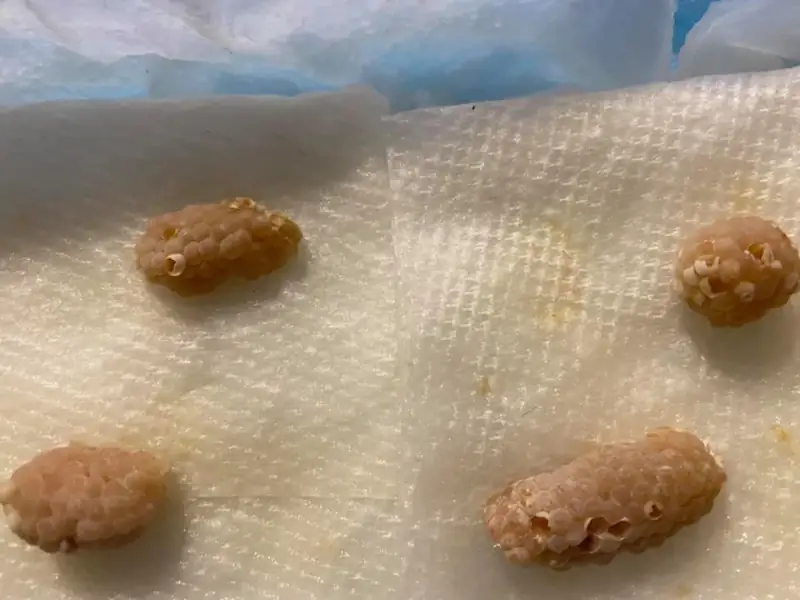
An infertile clutch of mystery snail eggs will stain a damp paper towel, whereas a fertile clutch won’t.
To perform this test, you will need a paper towel, a spray bottle filled with water, and a container or a plastic bag.
Here are the steps to perform the paper towel test:
- Carefully remove the mystery snail eggs from the aquarium or tank using a spoon.
- Place the eggs on a damp paper towel.
- Spray the paper towel and the mystery snail eggs with distilled water to moisten them.
- Leave the eggs on the damp paper for a day or two.
- Check for any distinctive stains on the paper towel.
A fertile clutch of mystery snail eggs will not stain the paper towel.
Remember that infertile eggs are not very common in mystery snails because the species has a long copulation period, with the female able to hold fertile sperm for up to 140 days.[2]
What to do with fertile snail eggs
When you let your mystery snail eggs hatch, you must be prepared to rear many baby snails. You may need a separate tank and food for the babies. Afterward, you can keep them, give them away or sell them online.
You can either let them hatch on their own or put them in an incubator.
Leave them as they were in the tank
Fertile mystery snail eggs will still hatch even when left in the tank. However, their hatching success rate is low because of the increased risk of snail eggs falling into the water.
The mystery snail babies will emerge and drop directly into the water. When using this method, ensure to move any tank mate that could eat the hatchlings.
Put them in an egg incubator
An incubator is a great place to hatch your mystery snail eggs. When moving the eggs to the incubator, you must be careful not to crush them. Wait at least two days for the fertile eggs to harden before moving them.
Here’s how to move the eggs into an incubator:
- Prepare the incubation box. You can also use a container with a secure lid.
- Dip three paper towels in water, squeeze the water out, and place them at the bottom of the incubation box.
- Gently move the eggs and put them on the damp paper towel.
- Seal the incubation box and place it in a warm and humid place. Floating the box in the tank is also okay.
What to do with infertile mystery snail eggs
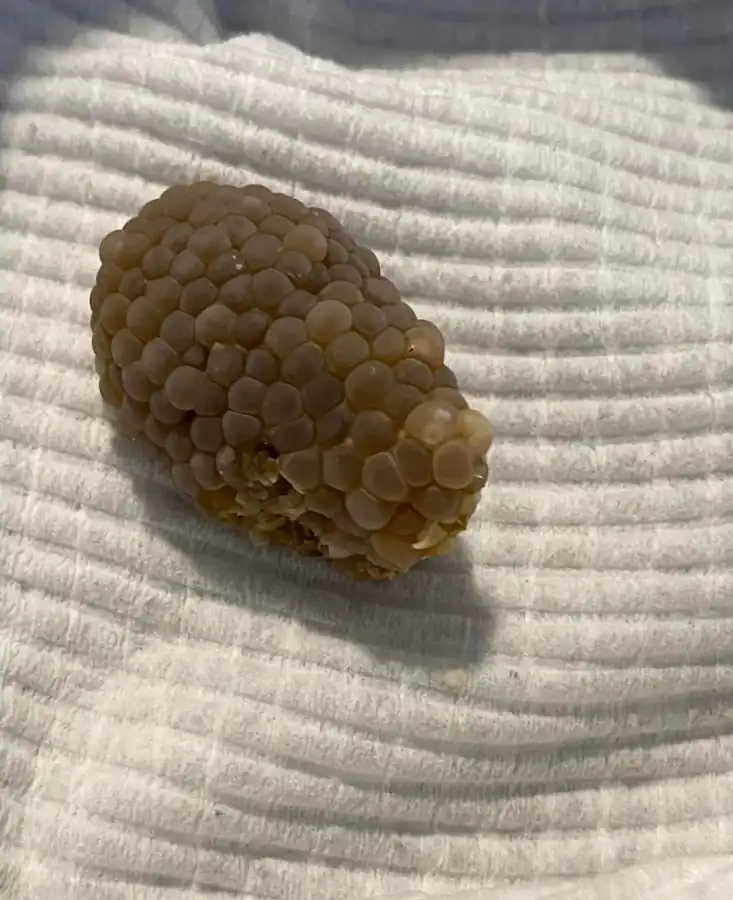
If infertile eggs are left in the tank, they can become a hazard because harmful bacteria can breed in them and affect other tank mates. Therefore it is essential to remove and dispose of them properly.
Crush the eggs
Put the infertile eggs in a polythene bag, crush them and dispose of them in the dustbin. Crushing them ensures that if there are any fertile eggs, they do not hatch in the wild or in places where they may be considered invasive species, such as in ponds.
Freeze the eggs
You can also wrap the infertile eggs with a paper towel and put them in the freezer for about twenty-four hours. Afterward, you can discard them in the dustbin or flash them in the toilet.
Conclusion
It is best to wait at least two weeks before checking whether the mystery snail eggs are fertile or infertile. Infertile eggs will smell bad, stain if placed on a paper towel, and will not change in size over time. Fertile eggs will grow in size and will have dark spots when approaching their hatching day.
References
- [1] S.E. Kingsbury, Donald F. McAlpine, Y. Cheng, E. Parker, and L.M. Campbell. A review of the non-indigenous Chinese mystery snail, Cipangopaludina chinensis (Viviparidae), in North America, with emphasis on occurrence in Canada and the potential impact on indigenous aquatic species. Environmental Reviews. 29(2): 182-200. https://doi.org/10.1139/er-2020-0064
- [2]Yusa, Yoichi & Wada, Takashi & Sakurai, Hironori & Tsuchida, Koji. (2002). Size and age at first copulation and spawning of the apple snail, Pomacea canaliculata (Gastropoda: Ampullariidae). Applied Entomology and Zoology – APPL ENTOMOL ZOOL. 37. 199-205. 10.1303/aez.2002.199.



